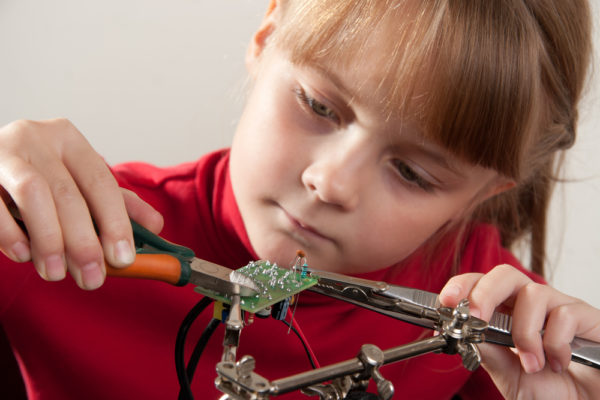Tinkering rolls personalized learning and critical thinking into one powerful package
Picture this: a grandparent working on a car in the garage or a kid figuring out the inner workings of a clock. A group of students with screwdrivers in hand taking apart old desktop computers to learn about circuits. Or a parent encouraging their child to invent contraptions for feeding pets or taking apart everyday objects such as old clocks and doorknobs to figure out how things work.
Tinkering in the modern context is a process of trying something to figure out what works or doesn’t to find your way to the best solution, often going through many iterations, or changes, along the way. Tinkering is more a philosophy than a single practice and thus can be applied to many forms of learning for all learners.
In a blog post discussing their work, authors Hunter Maats and Katie O’Brien discuss the science behind making mistakes and becoming experts. Experts are not made by practice alone, instead they deliberately tinker to determine which strategies are working or not working, and strategically develop areas that need improvement.
And it’s not just students that can benefit from a little tinkering. As an educator and lifelong learner, I have been submitted to, engaged myself in, planned, delivered, and coached others through countless professional learning opportunities. The ones that stick and are most successful, involve voice and choice. Most of those experiences have been facilitated in a manner which models how successful teachers teach.
Next page: A little control over learning makes a big difference
I’m not a MOOCs expert, but I was curious to see if they could replicate the best kinds of professional learning. So I made a conscious decision to try one because I wanted to know more about strategies and processes for integrating deeper learning. By getting involved, here’s what I learned:
- How to successfully structure and facilitate my learning experience using simple tools. I had full control over which panel discussions, readings or videos to consume as part of the course, and the structure of the MOOC allowed me to choose how to put into practice what I learned.
- Protocols for structuring discussions through Google Hangouts, as well as the power of a highly motivated and engaged Google+ community, all while earning a nifty badge.
By allowing me to pick and choose my path through the course, I had control of my learning. Voice and choice were foundational and made my experience personal and purposeful by allowing me to meet my needs in my own way. I’m not saying that a MOOC format will work for all learners or learning, but the personalization and tinker mentality warrant some thought when considering how to innovate professional learning. We have more than enough technology to support personalized and differentiate learning. The time has come to ask students and educators — I mean learners — what they want to learn, how they want to learn it, when they want to learn, plant a seed, then give them time to tinker.
Educators are masterful at tinkering to meet the needs of a diverse range of students. Students are masterful at tinkering to solve a problems in a video games. The more opportunities all learners have to explore what works or doesn’t work, the larger their intellectual toolbox. Many educators have not had the opportunity to be the drivers in their own professional learning and tinkering gives them this opportunity. If we want educators to facilitate, inspire, model, and design meaningful learning experiences for students that purposefully integrate technology, then professional learning should do the same.
Tinker Time tips
- Use the experts on campus
- Teachers, students, tech coordinators, parents, local businesses, etc.
- Know your audience
- Who needs what and when do they need it
- Make learning flexible and personal
- Voice and choice in what, how, and when
- Build in extra learning time for failure, trial-and-error, and space to really tinker and, therefore, learn. Sometimes you have to go slow to go fast. Give learners time to explore the new tool, strategy, or knowledge.
- When incorporating tinkering into learning, remember that the amount of scaffolding you will have to plan for depends on the participants. Communicate with people, not over people.
Tinkering is not about the product, it’s about the process. Enjoy the journey and don’t focus so much on having a spiffy product that can be presented or showcased. There is a time and a place for presenting, but true integration is about the journey and what was learned along the way. Tinkering is messy, but fosters deeper learning because learners are doing the thinking. Embrace it. Find balance. Find relief in the fact that you do not have to have all of the answers.
- TC- What student choice and agency actually looks like - November 15, 2016
- What student choice and agency actually looks like - November 14, 2016
- App of the Week: Science sensor meets your smartphone - November 14, 2016

